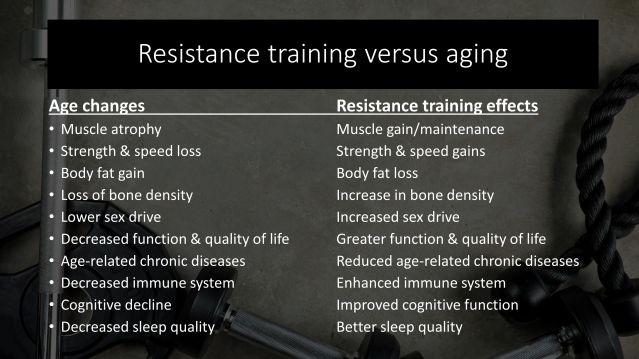Aging
Resistance Training as an Anti-Aging Remedy
You can benefit from resistance training beyond muscle-building.
Posted March 5, 2024 Reviewed by Ray Parker
Key points
- Resistance training is the most effective tool to slow or reverse many of the negative effects of aging.
- The benefits include improving bone density, hormone, cognitive, and skin health.
- Bodyweight exercises, home routines with dumbbells, or traditional weight training are all effective options.
If you want to live your best life for as long as possible, then we have to talk about aging. When it comes to health and happiness, aging is the invisible elephant in the room.
Aging, for instance, plays an outsized role in all the leading causes of death in the U.S. (cardiovascular diseases, cancer, diabetes, dementia). The singular exception is drug overdoses. Beyond raising our chronic disease risk, aging jeopardizes our hard-earned retirement years by exposing us to serious falls and accidents and making us more vulnerable to infections (age is the No. 1 risk factor for COVID-19 deaths.). Remarkably, even the risk of death by suicide increases significantly at older ages.
However, aging has usually secretly stolen our quality of life for decades. Metabolic health declines noticeably for most people by midlife, sapping our energy and predisposing weight gain. Bones, muscles, and cardiac function atrophy diminishing our capacity to engage with the world in the ways we enjoy.
Hormone function, such as sex hormones, growth hormone, insulin, and thyroid hormones, becomes impaired, affecting not just our appearance but our healing capacity, sexual function, and mental health. Even a restful night's slumber becomes elusive. Both sleep quantity and sleep quality (for reasons we can't yet explain.) decline with age1.
Faced with this grim picture of the aging process, it is perhaps no wonder that anti-aging is a more popular trend than ever. And there is good news to share. For the first time in the history of medicine and science, we now have credible theories about what is happening at the level of our genes and epigenome to cause aging2.
As impressive, we can also now boast of successful interventions in non-human animals that reverse what was previously considered permanent age-related declines3. This research will take time to sort out, what if anything it will mean for human applications, The best news of all is that we already have one potent tool proven to slow or reverse many of the biological and behavioral effects of aging. This tool is called resistance training.

If you were expecting this tool to be cosmetic surgery, nicotinamide mononucleotide (NMN) or nicotinamide riboside (NR) supplements, or even conventional cardiovascular (aerobic) exercise, this conclusion may come as a surprise. Yet the science is unequivocal: Regular resistance training induces changes in the brain and body, from the micro level of the genes and epigenome to the macrostructure and function of hormones, bones, and organs—yes, muscle is an organ.4 This surpasses any treatment currently available for slowing and reversing the process of aging5.
Truth and Reality About Resistance Training
It is easy to get lost in the superficialities of resistance training. For decades, our most common cultural references for resistance training have been athletes gaining muscles for display and performance and Hollywood actors using weight training to buff themselves up for movie roles. All the emphasis has been on the outside.
Yet what the recent two decades of research have revealed is that the most important effects of resistance training occur on the inside. Consider:
- Want strong bones? Then, talk to your health providers about resistance training, not calcium supplements, because nothing works better for building bones than exposing them to resistance6.
- Want to lift and play with your children or grandchildren instead of watching them play from a park bench or a wheelchair? Then know that resistance training works at any age7, maintain independence as well as or better than cardio, and that resistance training should be on building functional strength, not flashy muscles (although you can do both.).
- Resistance training improves sexual function, probably through favorable changes in hormones in men and women8, and enhances cognitive function and emotional well-being in both sexes.
- Resistance training improves the youthfulness of our skin—perhaps better than aerobic exercise—by fighting excess inflammation9.
- Your strength levels—measured as simply as by a handgrip test by your doctor—may better predict your lifespan than the usual medical suspects, such as blood pressure, blood sugar, and cholesterol10. In addition to your lifespan, your strength and muscle mass predict how well you will live the final decades of your life better than anything else we've measured.
Summary
Resistance training is the closest thing to a fountain of youth we've yet discovered. And it doesn't have to be complicated, costly, or time-consuming. Body weight exercises, isometrics (e.g., planks), home routines with dumbbells, or traditional weight training in a gym, for example, all seem to work. So, simply pick the format that you find convenient. A resistance training partner is optional, although it enhances the experience for most.
But the time to start resistance training is now. It takes time to develop consistent training habits. It takes time to learn resistance training exercises. And even when those variables are in place, it still takes time to build muscle and strength. This means that the sooner we start our resistance training journey, the sooner we get to reap the many rewards.
References
1. Li J, Vitiello MV, Gooneratne NS. Sleep in Normal Aging. Sleep Med Clin. 2018 Mar;13(1):1-11. doi: 10.1016/j.jsmc.2017.09.001.
2. Lu, Y.R., Tian, X. & Sinclair, D.A. The Information Theory of Aging. Nat Aging 3, 1486–1499 (2023). https://doi.org/10.1038/s43587-023-00527-6
3. Yang J, Petty CA, Dixon-McDougall T, Lopez MV, Tyshkovskiy A, Maybury-Lewis S, Tian X, Ibrahim N, Chen Z, Griffin PT, Arnold M, Li J, Martinez OA, et al. Chemically induced reprogramming to reverse cellular aging. Aging (Albany NY). 2023 Jul 12; 15:5966-5989 . https://doi.org/10.18632/aging.204896
4. Pedersen BK. Muscle as a secretory organ. Compr Physiol. 2013 Jul;3(3):1337-62. doi: 10.1002/cphy.c120033.
5. Fragala, Maren S.1; Cadore, Eduardo L.2; Dorgo, Sandor3; Izquierdo, Mikel4; Kraemer, William J.5; Peterson, Mark D.6; Ryan, Eric D.7. Resistance Training for Older Adults: Position Statement From the National Strength and Conditioning Association. Journal of Strength and Conditioning Research 33(8):p 2019-2052, August 2019. | DOI: 10.1519/JSC.0000000000003230
6. Watson SL, Weeks BK, Weis LJ, Harding AT, Horan SA, Beck BR. High-Intensity Resistance and Impact Training Improves Bone Mineral Density and Physical Function in Postmenopausal Women With Osteopenia and Osteoporosis: The LIFTMOR Randomized Controlled Trial. J Bone Miner Res. 2018 Feb;33(2):211-220. doi: 10.1002/jbmr.3284.
7. Peterson MD, Rhea MR, Sen A, Gordon PM. Resistance exercise for muscular strength in older adults: a meta-analysis. Ageing Res Rev. 2010 Jul;9(3):226-37. doi: 10.1016/j.arr.2010.03.004.
8. Lara LA, Ramos FK, Kogure GS, Costa RS, Silva de Sá MF, Ferriani RA, dos Reis RM. Impact of Physical Resistance Training on the Sexual Function of Women with Polycystic Ovary Syndrome. J Sex Med. 2015 Jul;12(7):1584-90. doi: 10.1111/jsm.12909.
9. Nishikori S, Yasuda J, Murata K, et al. Resistance training rejuvenates aging skin by reducing circulating inflammatory factors and enhancing dermal extracellular matrices. Sci Rep. 2023;13(1):10214. doi:10.1038/s41598-023-37207-9
10. Rantanen T, Guralnik JM, Foley D, et al. Midlife Hand Grip Strength as a Predictor of Old Age Disability. JAMA. 1999;281(6):558–560. doi:10.1001/jama.281.6.558




